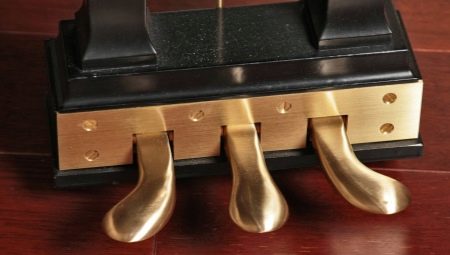Why do you need piano pedals?

A piano or upright piano is a complex instrument. It includes a case, keyboard and more. This musical instrument was invented in the early 1700s. Pedals began to be used by the end of the 18th century. And they were invented by two Englishmen. The invention of the right pedal mechanism "forte" belongs to Beyer, and the left - "piano" - Broadwood.


Peculiarities
The pedal mechanism of the instrument consists of levers that are operated by means of the feet. Currently, the piano is installed from 2 to 2 pedal mechanisms. They were created to change the sound of strings and are essential.
A earlier, before the creation of pedal mechanisms, retractable levers were used, which were controlled by the knees.


On a grand piano or pianoforte, such a device affects the timbre of the sound, its duration, volume and dynamics. In other words, they enhance the expressiveness of the instrument and enhance the music. It was thanks to them that at one time it turned out to give the piano sound more liveliness and brightness.
It should be emphasized that piano or grand piano pedals can significantly change and adjust the sound. You must use them wisely. Let's take a closer look at each of the pedals.
Left Pedal Assignment
The left pedal (or the second) reduces the volume of the sound, as it moves the hammers to the right. As a result, the blow falls on two strings. Another name for the left pedal is piano. Translated from Italian, it means "quiet".


It should be noted that the left mechanism manifests itself differently on different instruments. This aspect applies to other pedals as well. On the piano, he moves the hammers towards the strings to the right. On the piano, the whole mechanism is shifted.
In notes, the left pedal is designated at the moment of pressing as una corda. When it's time to take it off, write tre corde or tutte le corde.
What is the average for?
This mechanism in the piano has a delay function. But it is not installed everywhere, mainly on pianos. It selectively raises some of the dampers, and they only work when the pedal is depressed. The rest of the dampers do not change functions during this time. Often the middle pedal is used to delay bass notes.
A piano damper is a soft pad that dampens the strings. And also the damper mechanism eliminates unwanted hum when playing.


On the grand piano, the middle pedal activates the moderator. A moderator is a device that is lowered between hammers and strings. This makes the sound quiet. This allows you to play the instrument without disturbing others.
It is sometimes used to simulate the sound of a harpsichord. For this, metal "coins" are attached to the muffler, which create this sound.
Role of the right pedal
The damper pedal (or third) is used to reduce the volume of the sound. She controls the dampers. As soon as the musician takes his hands off the keys, usually the strings are muffled and stop sounding. This pedal has the opposite effect of the left pedal.
It softens the contrast between the decaying sound and the sounding of the strings. This turns on the vibration of the remaining strings, and secondary sounds appear. Its other name is "forte", which has Italian roots.

The mechanism lengthens and fills the sound of the instrument. It is also the most commonly used on the piano.
In addition to the described 3 pedals, there is a fourth type of pedal mechanism. It is not used very often. This is a sustain pedal, which is also called a sustaining pedal or sostenuto. Translated, in a simple way, is sustain. This mechanism is similar to a right pedal.
How to use?
Often, beginners wonder about the purpose of the pedals on the piano. It should be noted that they are used to perform a wide variety of pieces of music. The right mechanism is necessary for smooth transitions from one sound to another. And there is no other way to do it.
The left mechanism has to be pressed quite rarely. Usually they have a low bass response. To use the pedals properly, depress and release them smoothly.


To care for them, it is recommended to polish them with a soft cloth and use products for metal surfaces. To prevent squeaking, you can try using a silicone lubricant.
How do you learn to use the right mechanism? Its application occurs for 2 points. For a delayed effect, press the instrument key first, and then the pedal, and for the direct effect, this is done at the same time.

To understand when it is necessary to use the pedal mechanism, the letter P or Ped is indicated in the notes. The moment of removal is marked with an asterisk.
In general, all pedal mechanisms are responsible for the sound of the strings. And most often musicians use the right pedal mechanism. However, often in musical scores it is impossible to correctly and accurately convey exactly where it is necessary to use this or that mechanism. This is the part of the instrument that is applied depending on the skill and sensitivity of the performer, and it is this part that determines how well the musician plays.









